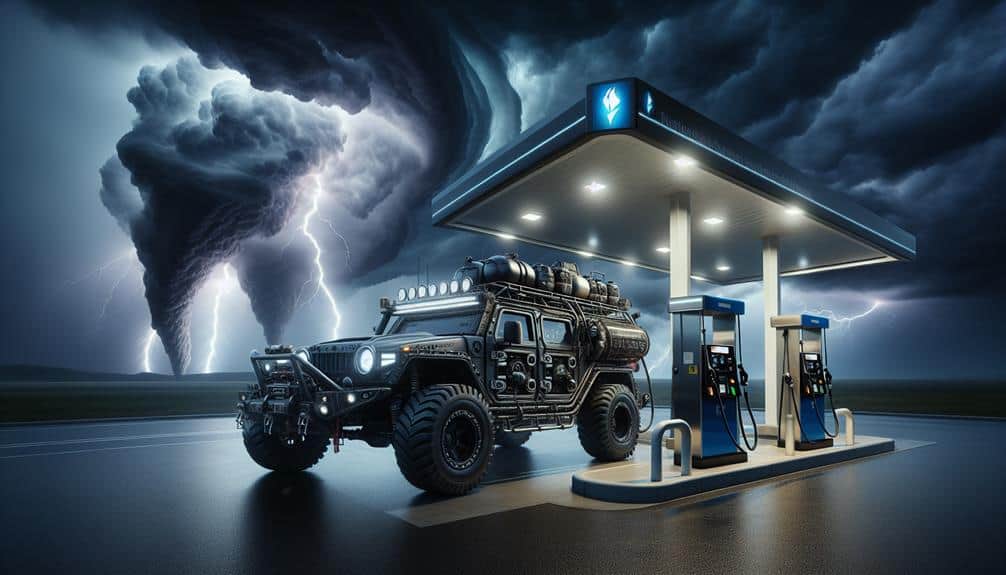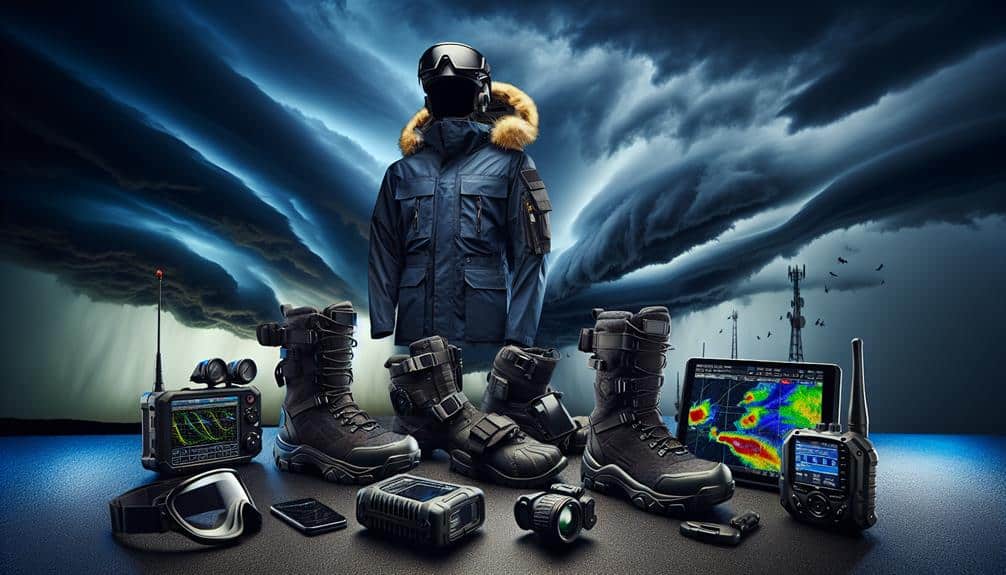We prioritize five key practices to guarantee storm chasing vehicle safety. First, we conduct regular inspections to catch potential issues early, checking engine fluids, electrical systems, and structural integrity. Second, we monitor tire condition, maintaining peak pressure and tread depth. Third, our vehicles are stocked with emergency equipment like first-aid kits, fire extinguishers, and repair tools. Fourth, robust communication systems keep us updated on weather and connected with our team. Finally, we implement efficient fuel management strategies, including real-time consumption monitoring and carrying auxiliary tanks. Applying these measures prepares us for challenging conditions and ensures we're ready for any situation.
Key Points
- Conduct regular vehicle inspections to ensure mechanical reliability and safety during storm chasing.
- Regularly check tire pressure and tread depth to maintain optimal grip and reduce risks on wet surfaces.
- Stock emergency supplies, including first-aid kits, fire extinguishers, and a well-organized maintenance toolkit.
- Maintain robust communication systems for real-time weather updates and effective coordination with team members.
Regular Vehicle Inspections
Conducting regular vehicle inspections is necessary for ensuring the reliability and safety of our storm chasing equipment. By adhering to strict safety protocols and maintenance schedules, we can reduce the risks associated with storm chasing. Regular inspections allow us to identify potential issues early, ensuring our vehicle condition remains ideal and enhancing our storm readiness.
We start with a thorough check of the engine, including oil levels, coolant, and other important fluids. These fluids are essential for maintaining the engine's performance under extreme conditions. Next, we inspect the electrical system, focusing on the battery, alternator, and wiring. Ensuring these components are in top shape prevents unexpected power failures during critical moments.
The vehicle's structural integrity is also a priority. We examine the chassis and suspension for any signs of wear or damage, as these elements are vital for handling rough terrains often encountered during storm chasing. Brake systems are scrutinized to guarantee maximum stopping power, an indispensable aspect of our safety protocols.
Additionally, we maintain a detailed log of all inspections and repairs in our maintenance schedules. This log helps us track the vehicle's condition over time, ensuring we're always prepared for the next storm.
Tire Condition Checks
Regularly evaluating the tire condition is important for achieving the best traction and stability during our storm chasing endeavors. Our tire checks should focus on two key aspects: tire pressure and tread depth.
Optimal tire pressure is vital for maintaining the vehicle's contact patch with the road, enhancing grip and reducing the risk of hydroplaning. We need to use a reliable tire pressure gauge to measure this and ensure it matches the manufacturer's specifications.
Tread depth is another important factor. Tires with insufficient tread depth struggle to channel water away, increasing the likelihood of slippage on wet surfaces. We should use a tread depth gauge to measure this; a minimum of 4/32 inch is recommended for safe driving in stormy conditions.
Additionally, inspecting for uneven wear patterns can help identify potential alignment issues or suspension problems that could compromise our vehicle's handling.
Emergency Equipment
Having the right emergency equipment is fundamental for guaranteeing our safety and preparedness during storm chasing missions. One key aspect of our readiness involves a well-stocked arsenal of emergency supplies. These include first-aid kits, fire extinguishers, and thermal blankets. Each item serves a specific purpose, from treating minor injuries to providing warmth in case we're stranded.
Equally significant is our vehicle maintenance toolkit. Thorough and meticulously organized, it should contain essential tools like wrenches, screwdrivers, and jumper cables. These tools are essential for addressing any mechanical issues that may arise during our high-stakes pursuits. We should also have a portable air compressor and tire repair kit to manage unforeseen tire punctures.
Furthermore, let's not overlook the significance of backup power sources. Portable generators and battery packs ensure our equipment remains operational, even when vehicle power is compromised. Flares and reflective triangles are indispensable for visibility, providing vital alerts to other motorists in low-visibility conditions.
Communication Systems
Maintaining strong communication systems is important for preserving coordination and safety during our storm chasing missions. Reliable systems enable us to receive real-time weather updates and stay connected with team members. GPS tracking is essential; it guarantees we always know everyone's location, allowing us to navigate treacherous terrain effectively. We integrate GPS tracking with mapping software to identify best routes and avoid hazardous weather cells.
Walkie talkies are indispensable for real-time, short-range communication. They work even when cellular networks fail, guaranteeing our team remains in constant contact. High-frequency radios provide another layer of redundancy, offering long-range communication when walkie talkies are out of range. Radio communication is crucial for staying updated on weather conditions, enabling us to make informed decisions quickly.
We utilize weather updates from multiple sources, such as NOAA radios and weather apps, to stay ahead of changing conditions. Real-time data helps us anticipate storm movements and adjust our plans accordingly.
Fuel Management

Effective fuel management is essential for maximizing our operational range and ensuring we can respond swiftly to evolving storm conditions. By implementing robust fuel monitoring systems, we can precisely track consumption rates, identify inefficiencies, and make data-driven adjustments. Advanced telemetry allows us to monitor fuel levels in real-time, giving us the edge we need when maneuvering unpredictable storm paths.
We should always plan our routes with an eye on gas stations' locations, ensuring we're never too far from a refueling point. This strategic planning is especially important in rural areas where gas stations are sparse. Knowing where the nearest refueling stations are can be the difference between staying on the storm or being stranded.
Moreover, carrying auxiliary fuel tanks can extend our operational range, providing us the freedom to chase storms without constant refueling interruptions. However, we must balance the extra weight and space these tanks consume against the added range they provide.
Frequently Asked Questions
What Types of Clothing Should Be Worn While Storm Chasing?
When storm chasing, we should wear protective gear, including sturdy footwear. Layering guarantees comfort and adaptability to weather changes. High-visibility clothing is critical for safety, allowing us to remain visible in low-light conditions and turbulent environments.
How Do You Choose the Safest Routes for Storm Chasing?
Exploring the storm's maze, we rely on weather tracking and safety protocols. We prioritize road conditions, ensuring emergency communication is robust. By analyzing meteorological data, we choose routes that maximize safety without compromising our pursuit of freedom.
What Should You Do if Caught in a Flash Flood While Chasing?
If we're caught in a flash flood while chasing, we should immediately initiate emergency response protocols and guarantee our vehicle preparation includes waterproofing and flotation devices to maintain safety and avoid getting trapped in rising waters.
How Do You Manage Stress and Anxiety During Intense Storms?
We manage stress and anxiety during intense storms by practicing breathing techniques and mindfulness. Prioritizing mental health, we employ coping strategies that include grounding exercises and maintaining situational awareness to guarantee we remain focused and composed.
What Are the Best Practices for Documenting and Sharing Storm Data Safely?
We prioritize data privacy and maintain digital security when sharing storm data. We use encrypted channels and secure storage to protect our information. By doing so, we maintain scientific integrity while safeguarding the freedom to share insights safely.


